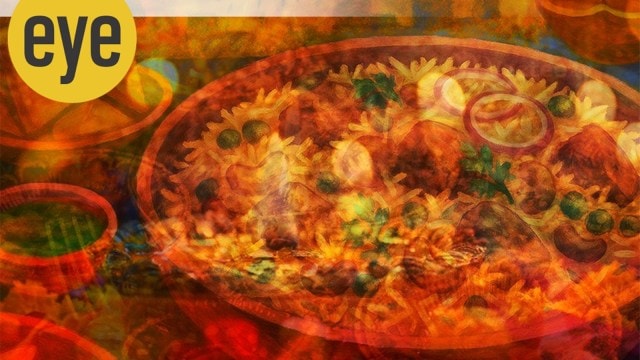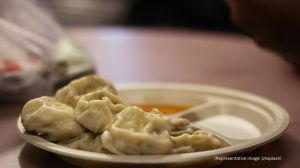The shared table that is Diwali
In our kitchen, occasions overlapped, flavours mingled and every dish told a story of coexistence.
 Discover the true spirit of Diwali through the ritual of cooking and sharing
Discover the true spirit of Diwali through the ritual of cooking and sharingIn our home, Diwali was never a single event. It was a choreography of a thousand small labours, each shining with its own quiet light. My earliest memories are of Panditji, our family’s Brahmin cook; Baba, the revered Man Friday, Dadi, my grandmother; and Maa, all moving through the kitchen in perfect rhythm — rolling, frying, tasting, humming bhajans under their breath.
There was the mathri, folded into fluted circles of devotion. The gujjiya, its dough rolled so thin you could glimpse the sweet filling beneath. The laddoo, each sphere shaped with patience and pride. And then there was Biryani Day — the day that transformed our home into a theatre of scent and sound.
Panditji would rise before dawn to make his legendary samosas — one hundred at least. Their patti, the outer skin, was fine. He never rushed, never sighed. His fingers moved with prayerful precision. When I close my eyes, I can still smell that moment when the first batch hit the oil — the kitchen filling with comfort-scented joy.
Today, Khagi and Vinod continue that tradition—two men who have inherited Panditji’s grace and Baba’s discipline. They cook with the same reverence, their laughter mingling with the hiss of oil.
My mother— 80 now, 81 this December — still makes gujjias. Just a few, but enough to honour her lineage. She stands beside Vinod in the kitchen, directing, tasting, adjusting, smiling that half-smile of approval when the dough is just right.
Meanwhile, I would be polishing the silver, rubbing life into brass and copper until the house itself gleamed. We set our plants at the thresholds; Maa’s rangoli traced stories in coloured powders. The diyas flickered among petals, and the air was perfumed with frying ghee, jasmine, and something else — belonging.
Our home overflowed with generosity. Neighbours brought their own treasures—chivda, chakli, coconut burfi, ratlami sev, shakkar paras. Each household shared what it did best. That, to me, is the spirit of Diwali: the festival of shared labour and open plates.
At the centre of our table stood our kathal biryani. We treated jackfruit as gently and seriously as meat: boiled till tender, browned till fragrant, marinated in a spiced yogurt and layered into saffron-scented rice. When the lid was lifted, steam rose like an aarti —saffron threads glowing, mint and coriander breathing freshness, fried onions glinting like small comets.
A dish born in Muslim kitchens, yet lovingly claimed in Hindu ones. That is India: Eid and Diwali, Holi and Navroz, Christmas and Baisakhi—festivals borrowing freely from each other’s spice boxes, believing in light without ownership.
When I moved to New York, I carried Diwali in my suitcase. I set a table that had no borders. The kathal biryani sat beside Gujarati fafda, Tamil vazhakkai fry, Bihari thekua, Bengali naru. A Sindhi friend brought seyalbhaji; a Goan neighbour arrived with neuri. Together they told a story larger than mine: that food is India’s most fluent language of coexistence.
For centuries, our kitchens have proven what our politics often forget—that we have always cooked together, eaten together. Each spice in the masala box has learned to live with another.
I’m reminded of that old NCC anthem:
“Bikhre bikhre taare hain hum, lekin jhilmil ek hain, hum sab Bharatiye hain” (Scattered stars we are, gathered strands we are, all of us woven into one India). That line could well describe our festivals, and every thali that holds them.
When the first guest arrives, I hand over a samosa, warm and fragile in my palm. She breaks it open; steam curls upward; time softens. Then the gujjias, the mathris, the laddoos, and the shining bowl of biryani—each bite telling a piece of who we are.
In that shared table lies the true light of Diwali: not a single flame declaring victory, but a constellation of small, steadfast ones illuminating one another.
May your table this year be wide. May your food travel freely. May you borrow a dish from another’s festival and make it your own. For when we eat across borders, we do more than celebrate—we keep the light alive.
*****************
Kathal (Jackfruit) Dum Biryani — by Suvir Saran
(serves 6–8)
Ingredients
For the rice
- 2 cups aged basmati rice, rinsed and soaked 30 minutes
- 10 cups water
- 1½ tsp salt
- Whole spices: 6 black peppercorns, 4 cloves, 4 green cardamom, 2 bay leaves, 1-inch cinnamon
For the jackfruit
- 750 g raw jackfruit (kathal), cleaned and cut into 1½-inch chunks
- ½ tsp turmeric, 1 tsp salt (for parboil)
- 4 tbsp ghee (or neutral oil), divided
- 2 medium onions, thinly sliced (for birista/fried onions)
- 1½ tbsp ginger-garlic paste
- 1 tsp red chilli powder (to taste)
- 1 tsp coriander powder
- ½ tsp roasted cumin powder
- ½ tsp garam masala
- ¼ tsp ground black pepper
- ½ cup thick dahi (yogurt)
- 1½ tsp salt (adjust to taste)
For the green chutney (add near the end)
- 1 cup coriander leaves, ½ cup mint leaves
- 8–10 curry leaves
- 2 green chillies
- 1-inch ginger, 2 small garlic cloves
- 1 tbsp lemon juice, ¼ tsp salt
- For layering
- ¼ cup warm milk with a pinch of saffron
- 2 tbsp ghee
- 2 tbsp chopped coriander + 2 tbsp chopped mint
- Reserved fried onions (birista)
Method
1. Parboil rice. Bring water to boil with salt and whole spices. Add soaked rice; cook to 70–75% done (a firm bite). Drain; spread on a tray.
2. Prep kathal. Parboil jackfruit in water with turmeric and salt for 8–10 min till just tender; drain well and pat dry.
3. Birista. Heat 2 tbsp ghee; fry onions to deep golden. Remove and reserve.
4. Brown the jackfruit. In the same pot, add 2 tbsp ghee; brown the parboiled kathal on medium-high till the edges caramelise.
5. Marinate and cook. Add ginger-garlic paste; sauté 1 min. Lower heat; add chilli, coriander, cumin, garam masala, black pepper; cook 30–45 sec. Stir in yogurt and ¾ of the birista; season with salt. Simmer 5–6 min till thick, glossy, and the fat separates. (If dry, splash in 2–3 tbsp water.)
6. Green chutney. Blend all chutney ingredients smooth. Taste for salt and brightness.
7. Layer. In a heavy, oven-safe (or thick-bottomed) pot, spread half the rice. Top with all the kathal; drizzle half the saffron milk, half the chutney, half the herbs, half the remaining birista, and 1 tbsp ghee. Finish with remaining rice; top with the rest of saffron milk, chutney, herbs, birista and 1 tbsp ghee.
8. Dum. Seal (tight lid or foil). Cook 10 minutes on the lowest stove flame over a heat diffuser/tawa, then 15 minutes in a 180°C oven (or keep on very low flame 20–25 minutes total if not using oven). Rest 10 minutes.
9. Serve. Fluff gently, lifting from the bottom to keep layers intact. Eat with raita and a squeeze of lime.
Notes & swaps
- For a vegan version, use oil instead of ghee and plant-based yogurt.
- For a festive flourish, scatter toasted cashews/raisins over the top.
- The green chutney is your “late lift”—folding in brightness without greying the rice (add mostly on the layers, not stirred into the rice).



- 01
- 02
- 03
- 04
- 05




























